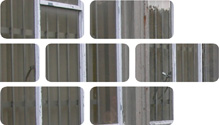
Glass Inert 17 02 02
Flat or plate glass is used for a range of structural and non-structural purposes. Glass is either rolled or cast into various styles and thicknesses and is often toughened, laminated, coated or wired. It is of varying strength and colour depending on the desired performance and architectural finish. Some glass is of historic importance and valuable.
Usage & Probable Locations
Glass has many uses in construction as it provides a transparent or translucent aperture. It is used for windows, doors, paneling, screens, curtain walling, external cladding, roof lights, specialist flooring and louvres. It is located throughout the building in the main frame, internal walls, corridors, on the roof, for architectural features and lighting.
Personal Protective Equipment
PPE requirements indicated are for guidance purposes only. DRIDS has identified the PPE that is mandatory on all demolition projects and ones that may be required subject to site specific Risk Assessment & Method Statement (RAMS). Hover over the icon to determine the types of PPE required for the removal of this material.
Removal, Segregation & Storage
Glass panels that are destined for reuse should be deconstructed, segregated and stored carefully and safely, especially those of architectural or historic value. They should be stored flat or upright to prevent cracking and away from plant movements to prevent breakage. Crushed glass that is destined for recycling should have all contaminants such as brick, ceramic, rubber, silicon, metal and plastic removed to meet the quality protocol for recycled glass. There is little need to store crushed glass inside a building or under cover as they are robust against incremental weather.
Fixtures, Fittings & Connections
Glass has traditionally been fixed in place using putty, silicone, lead, beads, glazing strips and rubber gaskets. Some products are double or triple glazed that are sealed with a rubber mastic around the edges before fixing within a frame. Some glazed products such as tiles and kitchen surfaces will be laid into place using mortar, screed or other binding agent. Glass will sometimes be coated with a reflective material for architectural purposes which can be difficult to remove. Structural elements such as curtain walling will be fixed with nuts, bolts, pins and rubber washers within a space frame made from alloys or stainless steel.
Health & Safety
Subject to task-specific Risk Assessment & Method Statement (RAMS). Use correct protective equipment when working with glass. Wear kevlar grip gloves when handling glass products and crushed materials to prevent cuts and abrasion. Use eye protection or full face mask when using hand tools. Do not rest glass panel edges on boots. Do not walk on glass. Only use harness protection at height as a last resort. Only use 360 plant, cranes and glass suckers if appropriately trained.














